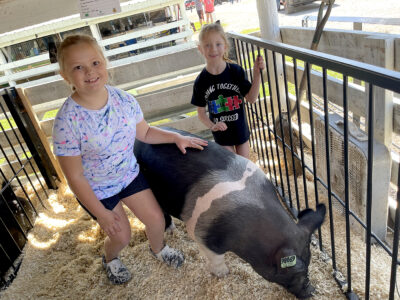Setting the stage
Crew of volunteers, contractors readies site of Downtown Country Jam
-
-Messenger photo by Brandon Brueschke
Workers set up the stage Friday for the Downtown Country Jam concert.
-
-Messenger photo by Brandon Brueschke
Workers set up the stage Friday for the Downtown Country Jam concert. Many of the people involved are volunteers.

-Messenger photo by Brandon Brueschke
Workers set up the stage Friday for the Downtown Country Jam concert.
There is a lot of work put in to get the Downtown Country Jam set up, whether that comes with the planning of the event, booking the artists to perform, or the physical set up of the stage.
Jim Reed, the president of Shellabration Inc., highlighted the amount of time and energy it takes to put on events like tonight’s concert.
“It is a multiple year long process from start to finish,” he said. “And I like to tell people that nothing that we do is rocket science. There isn’t anything that requires an organic chem degree or, you know, physics degree. It’s just a lot of tasks. All daisy chained together. ”
Reed said that the planning process of this event started about a year ago with finding a workable date and gathering the artists to perform. When talking about the crew for setting the event up, Reed said, “We have a board of 16 unpaid volunteer board members that serve as the leadership and they’re committed. The crew that we have, I would put up against any special event. They’re detail oriented, professional, reliable, and what’s cool, though, so as we’ve got this core of volunteers, but we also have tasks it’s harder to find people or skill sets to do lighting, staging, things like that. So what you see here as a cross between contractors, volunteers doing what they can, and then also people that have the skill sets to do, you know, lighting design and things like that.”
The crew was quickly assembling the stage for the event Friday. They worked together as a smoothly running crew. They were connecting support beams to hold up the stage while others were unloading equipment.

-Messenger photo by Brandon Brueschke
Workers set up the stage Friday for the Downtown Country Jam concert. Many of the people involved are volunteers.
“This is unique this year that we’re using a hydraulic stage as opposed to a truss stick where everything is built and cam bolted together,” Reed said. “It’s far easier this year. This hydraulic stage is literally going to cut off probably four hours because usually we’d be building everything, one piece at a time. So that trailer once it was parked, the roof started moving up and the stage came down and then we just added on to it. So you’re seeing the year where it’s far more fast and efficient than it would have been in any year prior. And this is our first time ever using a hydraulic stage.”
Reed went on to describe the physical set up as “the non-sexy dark underside belly of doing production.”
To elaborate, Reed explained, “So when people come you know, we get it all dressed up around the front, but when you look underneath the stage, all the the stuff that’s buried rolling cases, boxes, you know this and that, if you actually came and look from behind the stage, it isn’t pretty, but at night when it gets dark and the lights go on, and it looks so pretty. It’s such a dichotomy between behind stage and what the public actually sees.”
Another aspect of assembly that Reed discussed was the materials used. Reed brought up all the fencing, tents, and lining mechanisms along with bigger infrastructure like generators and lighting towers.
Ted Bodensteiner, the vice president of Shellabration Inc, joined the conversation to talk about more of the systems they have to set up these shows.
“I certainly take up all the little nuances and I play Ying to Jim’s Yang on making decisions,” Bodensteiner said.
Bodensteiner and Reed began discussing the ways they incorporate the experiences of putting on these events to enhance future ones. One specific thing Bodensteiner brought up was working on an event in Nebraska where they lit up the portable toilets.
Reed expanded on that by saying, “I’m going to focus on porta potties, as crazy as that sounds. So he saw an idea. We plagiarized it, did it here. And in the reviews that we get on Facebook. We actually have had a number of women that have commented on the fact that they felt safer and cleanliness because our porta potties were lit.”
“No detail goes untouched,” Bodensteiner said. “Everything’s in the details and we try to get the details right.”
Reed referred to this evolution process as “continuous improvement” and said that “Every time we do something, we’re always looking at it, you know, on the granular level, and that’s that attention to detail.”
They highlighted the way in which they mark the ground with available spacing for people as another detail they try to perfect. All of this also showed how many facets of these events they have to take into account. They have to focus on the audience’s entertainment, the artist’s needs, and not to forget public safety.
While talking about safety, Reed said, “We’re going to have in the grid, 12 uniformed officers, we will have six Fort Dodge Fire and Rescue EMTs, and we will have law enforcement officers aerially spot in on each of two buildings.”
Reed added, “we’re doing what is necessary to make sure that this is a fun, enjoyable, safe environment for the people.”
Bodensteiner and Reed added that they are setting up concrete barriers to block cars from the crowd.
One aspect of this show that differs from some of their other ones set up wise is that of location. This being in the downtown street adds a level of ease when it comes to set up. Bodensteiner explains that “It is easier because the lining is easier to wash off or rub away in fields whereas it is much more resilient on pavement. Also we have to worry less about messing with the turf.”
Bodensteiner also stated how the buildings make less work when it comes to setting up fencing.
The one aspect of the set up of these events that plays a major part is that of the community, according to Bodensteiner. These events wouldn’t be possible without the support of the community and the volunteers that choose to physically help out. These events take a lot of hard work throughout the year, but it all becomes worth it to give the community a wonderful night.






